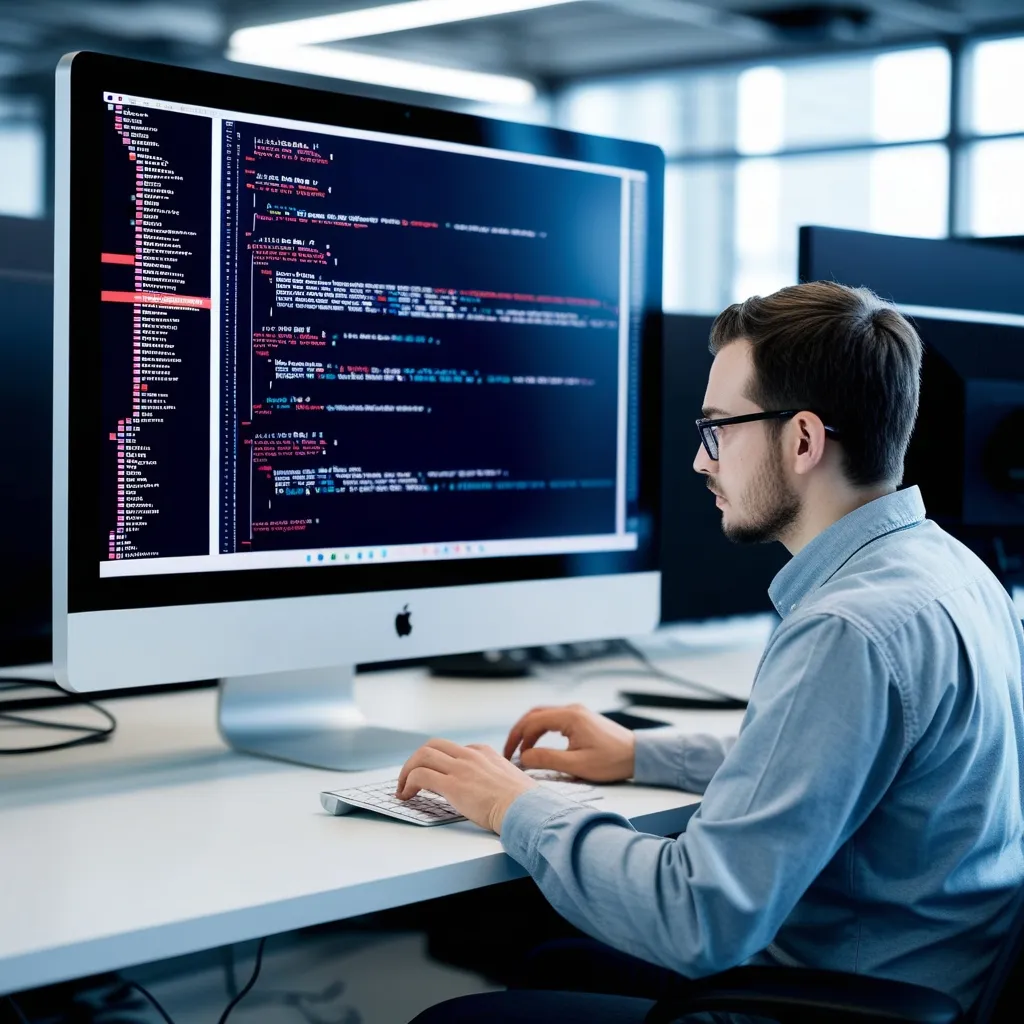Ever wondered what it’d be like to have your computer read your emotions? Well, buckle up because we’re about to dive into the fascinating world of real-time emotion detection using facial recognition!
Let’s start with the basics. Emotion detection is all about using tech to figure out how someone’s feeling just by looking at their face. It’s like having a superpower, but instead of flying, you’re decoding facial expressions. Pretty cool, right?
Now, you might be thinking, “Okay, but how does this actually work?” Great question! It’s a combo of facial recognition and machine learning. First, we need to teach our computer to recognize faces. This involves detecting key facial features like eyes, nose, and mouth. Then, we train it to understand different expressions and link them to emotions.
One popular way to do this is using something called a Convolutional Neural Network (CNN). It’s a fancy term that basically means we’re using a type of artificial intelligence that’s really good at analyzing visual data. Think of it as giving your computer a crash course in reading facial expressions.
Let’s get our hands dirty with some code. Here’s a simple example using Python and the face_recognition library:
import face_recognition
import cv2
import numpy as np
# Load a sample picture and learn how to recognize it.
known_image = face_recognition.load_image_file("your_face.jpg")
known_face_encoding = face_recognition.face_encodings(known_image)[0]
# Initialize some variables
face_locations = []
face_encodings = []
face_names = []
process_this_frame = True
# Get a reference to webcam #0 (the default one)
video_capture = cv2.VideoCapture(0)
while True:
# Grab a single frame of video
ret, frame = video_capture.read()
# Only process every other frame of video to save time
if process_this_frame:
# Find all the faces and face encodings in the current frame of video
face_locations = face_recognition.face_locations(frame)
face_encodings = face_recognition.face_encodings(frame, face_locations)
face_names = []
for face_encoding in face_encodings:
# See if the face is a match for the known face(s)
matches = face_recognition.compare_faces([known_face_encoding], face_encoding)
name = "Unknown"
if True in matches:
name = "Your Name"
face_names.append(name)
process_this_frame = not process_this_frame
# Display the results
for (top, right, bottom, left), name in zip(face_locations, face_names):
# Draw a box around the face
cv2.rectangle(frame, (left, top), (right, bottom), (0, 0, 255), 2)
# Draw a label with a name below the face
cv2.rectangle(frame, (left, bottom - 35), (right, bottom), (0, 0, 255), cv2.FILLED)
font = cv2.FONT_HERSHEY_DUPLEX
cv2.putText(frame, name, (left + 6, bottom - 6), font, 1.0, (255, 255, 255), 1)
# Display the resulting image
cv2.imshow('Video', frame)
# Hit 'q' on the keyboard to quit!
if cv2.waitKey(1) & 0xFF == ord('q'):
break
# Release handle to the webcam
video_capture.release()
cv2.destroyAllWindows()
This code sets up a basic facial recognition system using your webcam. It’s a good starting point, but for emotion detection, we need to take it a step further.
To add emotion detection, we’d need to train our model on a dataset of facial expressions linked to emotions. There are several datasets out there, like FER2013 or CK+, that are great for this purpose. Once we’ve trained our model, we can integrate it into our facial recognition system.
Here’s where it gets really exciting. Imagine you’re building an app that adapts to your mood. Feeling stressed? It could automatically play some calming music. Feeling happy? It might suggest taking a selfie to capture the moment. The possibilities are endless!
But let’s be real for a second. Building a reliable emotion detection system isn’t all sunshine and rainbows. Faces are complex, and emotions even more so. What looks like a smile to one person might be a grimace to another. And don’t even get me started on the cultural differences in expressing emotions!
This is where machine learning really shines. By feeding our model tons of diverse data, we can teach it to recognize subtle differences and improve its accuracy over time. It’s like teaching a child to read facial expressions, but way faster and with way more data.
Now, you might be wondering about the ethical implications of all this. And you’d be right to do so. Emotion detection technology raises important questions about privacy and consent. It’s crucial to use this tech responsibly and transparently.
One way to address these concerns is by implementing strong data protection measures. For example, you could process all data locally on the user’s device, rather than sending it to a server. This way, users can feel more secure knowing their emotional data isn’t being stored or shared.
Let’s look at how we might implement a simple emotion detection function in Python:
from tensorflow.keras.models import load_model
import cv2
import numpy as np
# Load pre-trained emotion detection model
model = load_model('emotion_model.h5')
def detect_emotion(face_image):
# Preprocess the image
face_image = cv2.resize(face_image, (48, 48))
face_image = cv2.cvtColor(face_image, cv2.COLOR_BGR2GRAY)
face_image = np.reshape(face_image, [1, face_image.shape[0], face_image.shape[1], 1])
# Make a prediction
emotion_prediction = model.predict(face_image)
# Map the prediction to an emotion label
emotion_labels = ['Angry', 'Disgust', 'Fear', 'Happy', 'Sad', 'Surprise', 'Neutral']
emotion = emotion_labels[np.argmax(emotion_prediction)]
return emotion
# Use this function in your main loop
# emotion = detect_emotion(face_image)
# cv2.putText(frame, emotion, (left + 6, bottom - 6), font, 1.0, (255, 255, 255), 1)
This function takes a face image, preprocesses it, and feeds it into our pre-trained emotion detection model. The model then predicts the most likely emotion, which we can display on our video feed.
But wait, there’s more! We can take this even further by tracking emotions over time. This could be useful for applications like mood tracking or even in fields like market research to gauge audience reactions.
Here’s a quick example of how we might track emotions over time:
import time
emotion_history = []
start_time = time.time()
while True:
# ... (previous face detection code)
for (top, right, bottom, left), name in zip(face_locations, face_names):
face_image = frame[top:bottom, left:right]
emotion = detect_emotion(face_image)
current_time = time.time() - start_time
emotion_history.append((current_time, emotion))
# ... (display code)
# Every 60 seconds, print a summary
if current_time % 60 < 1:
print("Emotion summary for the last minute:")
for timestamp, emotion in emotion_history[-60:]:
print(f"Time: {timestamp:.2f}s, Emotion: {emotion}")
This code snippet keeps track of detected emotions over time, storing them in a list. Every minute, it prints out a summary of the emotions detected in the last 60 seconds. You could easily modify this to create more complex analyses or visualizations.
Now, I don’t know about you, but I find this stuff fascinating. The idea that we can teach computers to understand something as complex and nuanced as human emotions is mind-blowing. And we’re just scratching the surface here!
As we continue to refine these technologies, who knows what kind of applications we’ll see in the future? Maybe we’ll have smart homes that adjust the lighting based on our mood, or cars that can detect if we’re too angry to drive safely.
Of course, as with any powerful technology, it’s important to consider the potential downsides. We need to be mindful of privacy concerns and the potential for misuse. But used responsibly, emotion detection technology has the potential to make our lives easier, safer, and maybe even a little bit happier.
So, what do you think? Are you excited about the possibilities of emotion detection, or does it make you a bit uneasy? Either way, it’s clear that this technology is here to stay, and it’s only going to get more sophisticated from here.
Whether you’re a developer looking to incorporate emotion detection into your next project, or just a tech enthusiast curious about the future of AI, I hope this deep dive has given you some food for thought. Who knows? Maybe you’ll be inspired to create the next big emotion-aware app. Just remember to use your powers for good!






